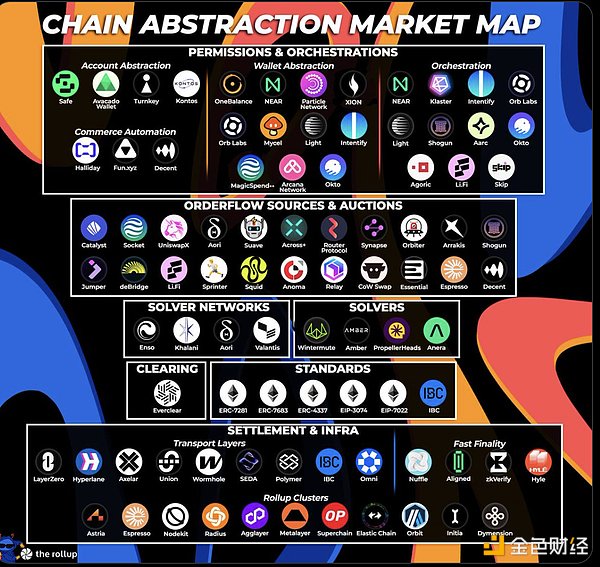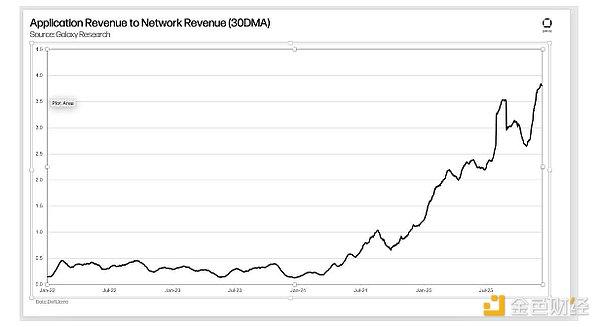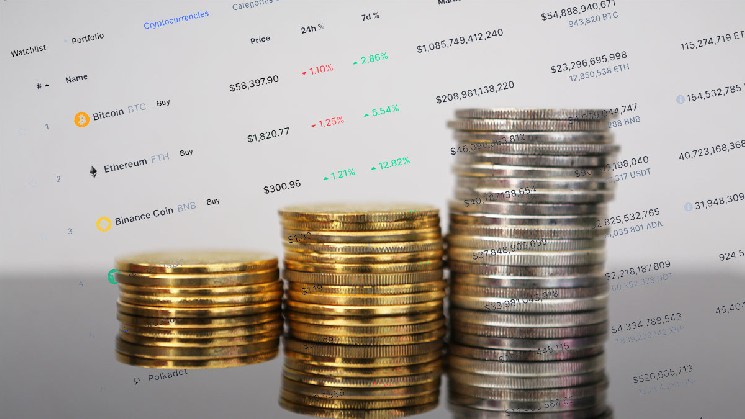Author: Yue Xiaoyu Source: X, @yuexiaoyu111
For the term "chain abstraction", different people have different understandings and interpretations, so there is no need to get bogged down in too many conceptual disputes. We can look at specific projects. Only by combining specific projects can we turn an abstract concept into a concrete entity. Here, the chain abstraction landscape of Rollup Ventures is used as a blueprint for specific analysis.

This diagram basically covers most of the products related to chain abstraction on the market, and even further generalizes the scope of chain abstraction, including all products that can improve user experience.
However, the value of the panoramic diagram lies in its ability to give us an overview of the market, the position of different projects, and the value they play.
01 Unleash your imagination: If a chain is a country, what should the future of a multi-chain ecosystem be like?
To better understand this chain abstraction panorama, let's not worry about the specific concepts of each module, but use analogies to understand this big framework more intuitively.
We can imagine a super-modern and intelligent country alliance (blockchain ecosystem) composed of multiple countries (multiple blockchains):
1. Permissions & Orchestrations
(1) Account Abstraction: This is your smart ID card that allows you to seamlessly access services (blockchain applications) in any country in the alliance without having to apply for a separate ID card in each country. You just need to swipe this unified ID card, and the system will know that you are a legitimate resident and automatically handle your access permissions (transaction signing).
(2) Commerce Automation: In these countries, you can use a smart payment system for shopping. This system automatically handles the conversion and payment of different national currencies, ensuring that your payments are automatic, fast, and seamless no matter which country you are in.
(3) Wallet Abstraction: This is your smart bank card that automatically integrates all your bank accounts (assets on different blockchains) in different countries. You don't need to go to different bank counters in each country to withdraw money or transfer funds, as all your financial management is done in one place.
(4) Orchestration: The country alliance has a central coordination center that is responsible for managing your cross-country travel plans (cross-chain transactions). If you need to go from one country to another, the center will automatically arrange your transportation, hotel reservations, etc., ensuring that your travel (transactions) within the alliance is a single, smooth experience.
2. Orderflow Sources & Auctions: In the market of the country alliance, goods (assets) are allocated to consumers through auctions. Auctions ensure that you get the goods you need at the best price, and actually help you find the best trading price in the alliance.
3. Solver Networks: The country alliance has a problem-solving center with many professional solvers. They are responsible for solving complex problems between countries, such as how to efficiently allocate resources or solve traffic congestion (improve transaction efficiency), ensuring that the entire alliance runs more smoothly.
4. Solvers: These professional solvers are like the traders of the country alliance, who transfer goods (assets) between different countries to ensure the smooth flow of goods between countries, provide liquidity, and reduce price differences that may be encountered when buying and selling in the market.
5. Clearing: In this country alliance, after each transaction, the clearing center will ensure that each transaction is correctly recorded and paid, ensuring that the accounts of all countries are balanced, similar to ensuring the final settlement of transactions between blockchains.
6. Standards: The currency, language, laws, etc. used by the entire alliance all follow unified standards, just like different blockchains follow standards such as ERC and EIP. These standards ensure that you can communicate, trade, and use services seamlessly no matter which country you are in.
7. Settlement & Infra
(1) Transport Layers: It's like the high-speed rail system of the alliance, which allows you to move assets and information quickly and securely between countries, although the speed may be slightly slower than other methods, but it provides reliability and high security.
(2) Fast Finality: This is a fast lane system that ensures the goods (such as the dishes you order in a restaurant) you purchase can be prepared immediately, without having to wait a long time.
(3) Rollup Clusters: Imagine these countries (blockchains) improving the traffic capacity (transaction processing capacity) of each country through shared infrastructure (infrastructure), while also promoting interconnection between countries (cross-chain interaction).
Through this unified country alliance analogy, you can now have a more vivid understanding of the functions and values of each module in the chain abstraction panorama. They work together to provide an efficient and seamless country (blockchain) alliance experience.
02 Going back to the blockchain itself, we can look at the exact meaning of each module
1. Permissions & Orchestrations
(1) Account Abstraction: Simplifying user account management and transaction signing processes through smart contracts, not only reducing private key management risks, but also lowering the user entry threshold.
(2) Commerce Automation: Automating various processes involved in blockchain business activities, reducing the complexity of manual operations. For example, through automated payment and settlement, it supports a wider range of payment options.
(3) Wallet Abstraction: Unifying the management of assets on different chains, providing a more concise user interface, and simplifying cross-chain asset management, so that users do not need to manually bridge or exchange tokens.
(4) Orchestration: Coordinating multi-chain operations, providing automated and efficient multi-chain transaction processing, supporting complex multi-step transactions, such as buying assets on one chain, transferring across chains, and then staking on another chain.
2. Orderflow Sources & Auctions: Managing and optimizing transaction flows to ensure transactions are executed at the best price, supporting cross-chain liquidity, and finding the best price execution through auction mechanisms.
3. Solver Networks: Handling complex tasks in the blockchain through distributed computing, such as transaction verification and price discovery.
4. Solvers: Focusing on optimizing blockchain functions, reducing transaction risks by quickly processing user intentions, and conducting arbitrage and cross-chain asset transfers to improve market efficiency.
5. Clearing: Ensuring the accurate settlement and asset rebalancing of cross-chain transactions.
6. Standards: Standardizing blockchain operations, such as account abstraction and cross-chain settlement, to promote coordination between different systems.
7. Settlement & Infra
(1) Transport Layers: Realizing the transfer of data and assets between blockchains, ensuring the security of communications.
(2) Fast Finality: Improving the final confirmation speed of transactions to enhance network efficiency and user experience.
(3) Rollup Clusters: Rollup groups that share infrastructure and liquidity, improving scalability.
03 Combining a specific user case to see the role of each module
Xiaoming is a cryptocurrency enthusiast who enjoys playing games on blockchain platforms. He owns crypto assets on multiple different blockchains and hopes to use these assets seamlessly in games.
1. Account Abstraction: Xiaoming logs into a cross-chain gaming platform through a wallet app that supports Account Abstraction (such as Avocado Wallet). He doesn't need to manage multiple private keys, just use a unified login interface. The wallet automatically handles the authorization and signing, ensuring security and convenience.
2. Commerce Automation: Xiaoming purchases a limited-edition game prop in the game. The transaction process is automatically completed through platforms like Halliday, and the payment can be made in any supported cryptocurrency or fiat currency, avoiding cumbersome payment procedures.
3. Wallet Abstraction: Xiaoming wants to view and manage his assets across different blockchains. Through platforms like OneBalance, he can see the consolidated status of all his assets without switching between different wallets, providing a unified asset management experience.
4. Orchestration: The purchased prop needs to be transferred from one chain to another where the game is running. Orchestration services like NEAR Protocol automatically handle the cross-chain movement of the asset, ensuring Xiaoming's prop can be used seamlessly in the game.
5. Orderflow Sources & Auctions: Xiaoming hopes to purchase virtual land in the game at the best price. Through platforms like Uniswap, his purchase intent is routed to multiple liquidity pools, and the best price is found through an auction mechanism.
6. Solver Networks and Solvers: The need to quickly execute Xiaoming's trading intent across different chains. Solver networks (such as Enso) and Solvers (such as Wintermute) calculate and optimize the trading path to ensure fast execution at a reasonable price.
7. Clearing: After the transaction is completed, ensure that all steps have been executed correctly. Platforms like Everclear ensure the final settlement of cross-chain transactions, and all participants receive the assets or services they are entitled to.
8. Standards: Xiaoming trades tokens on different chains. The ERC-7281 standard ensures the security and standardized operation of tokens during cross-chain transfers, and EIP-3370 helps avoid sending to the wrong chain.
9. Settlement & Infra: The need to quickly transmit data and assets across chains. Transmission layer protocols like LayerZero provide secure cross-chain communication, and fast finality solutions like Nuffle accelerate the final confirmation of transactions.
10. Rollup Clusters: The game needs to process a large number of user transactions. Through Rollup clusters like Optimism Superchain, the scalability of the network is enhanced, ensuring that the game can run smoothly even during peak times.
04 Summary
If a chain is a country, then the future of the multi-chain ecosystem is a network of nation-states.
Account Abstraction is to provide you with comprehensive services in this network of nation-states.
From the end to the beginning, only when we know what the end state of Account Abstraction is, can we truly understand the value of the Account Abstraction narrative, and all our efforts will have meaning.







